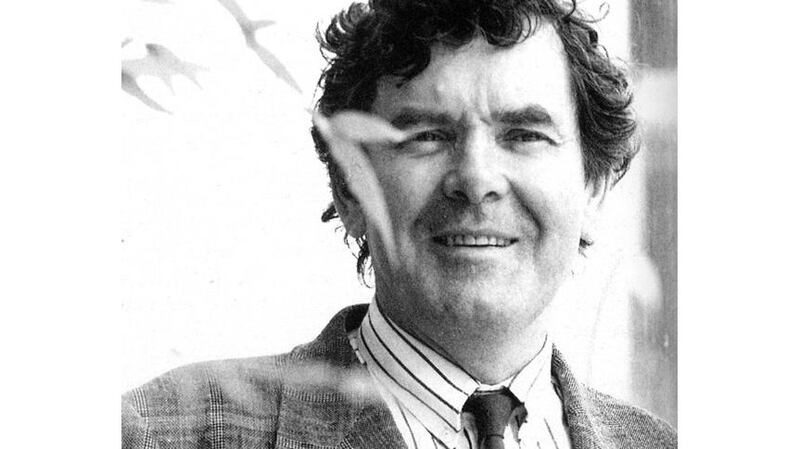Twenty years after his death, a new book, film and exhibition celebrate the work of the Dundalk-born structural engineer Peter Rice, who was one of the designers of, among other iconic buildings, the Pompidou Centre in Paris
Peter Rice was one of the “bad boys”, along with Richard Rogers and Renzo Piano. They had the bravado to “make a building for culture that looked like a machine, that was the opposite of monumentality and intimidation, of marble buildings,” as Piano says of Centre Pompidou in Paris.
“At Beaubourg in the early 1970s, we were all young, bad-boy humanists,” he recalls. “When Mr Honda came from Japan to visit us on the site, he said, speaking through a translator, that it was a beautiful building. We asked the translator why. And the reply came: because it is like a motorbike. Like a Honda!

“When people declared that Centre Pompidou looked like a refinery or like a factory we were very pleased to say yes, that is exactly what we wanted”, Piano says in an interview for Traces of Peter Rice, a new book published by Liliput Press about the life and work of the extraordinary Dundalk-born engineer.
For it was Peter Rice who invented the enormously long, cast-steel beams called “gerberettes” that made it possible for the Pompidou to have clear spans of floorspace, devoid of structural columns. Indeed, the gerberettes, which were finished by hand, became “the icon of the design”, as Jennifer Greitschus notes.
Head of exhibitions at Arup, the respected international engineering and architecture firm, Greitschus writes that Peter Rice was “inspiring not just because of his brilliance as an analyst, but because he was driven by a commitment to pushing the boundaries of his discipline of structural engineering.
“Rice established his reputation during the late 1970s and through the 1980s at a time when engineers were working with increasingly sophisticated computer technology. Were it not for his untimely death in 1992, he would no doubt have continued to integrate state-of-the-art systems into his own practice.”
Yet he also had love of craftsmanship, as shown by the Moroccan stonemasons who built the dry stone walls of the Full-Moon Theatre at Gourgoubès, in the Languedoc region of France, or the skill of the master plasterer who shaped the ferro-cement leaves for the roof profile of the Menil Collection museum, in Houston, Texas.
Rogers, Rice and Piano mixed architecture, beauty, structure and physics in the Pompidou. “I see him as an artist, a poet, a sculptor engineer or engineer sculptor, a humanist, a Brunelleschi of recent times,” Rogers says. “He crossed boundaries, stimulated all our imaginations and was always optimistic.
“Peter transformed the competition entry for Pompidou from a design that was in some ways too mechanistic into one that was humanistic. He had a natural sense of scale and proportion. He was an artist and a fine mathematician. He softened the whole look of the building through the way he reconfigured the structure.”
Rice’s first break came early in his career when he persuaded Jack Zunz, senior partner at Arup, to send him to Sydney as site engineer for the Opera House; its Danish architect, the late Jørn Utzon, had a lasting impact on him, underlining “the importance of detail in determining scale, in deciding the way we see buildings”.
On the site at Bennelong Point, in Sydney Harbour, “Peter’s contribution proved to be immense,” Zunz recalls. “He worked on the analysis of parts of the main roof and was central to our being able to start producing some drawings from which the roof structure could actually be built.” In effect, he made it stand up.
As architect Seán Ó Laoire writes, Rice’s “spiritual ancestor” was Richard Turner, the ironmaster who turned out the Curvilinear Range in the National Botanic Gardens, Glasnevin, and he was also hugely influenced by the Grand Palais in Paris, of which he said “that it is so fine and that we have failed to do as well since”.
Educated by the Christian Brothers in Dundalk, Rice was sent by his father to study engineering at Queen’s University in Belfast – unusual for 1950s Ireland. As his brother Maurice recalls, their LSE-educated father felt that Belfast, with its tradition in aeronautical and marine engineering, was “a more appropriate choice than Dublin”.
“Peter was always so healthy and full of life that the brain tumour came as a great shock to all and especially to him. The combination of a deadly prognosis and great restrictions on his sight were hard blows, at a time when he was in his fifties and his professional life was flourishing.” He was a great loss to structural engineering.
In his address to the Royal Institute of British Architects, on being awarded the Royal Gold Medal for Architecture, Rice described himself as “an engineer pure and simple”. He may have seen it that way, but there’s no doubt that his work transcended boundaries in what Ian Richie calls “the creative and inventive process”.
The work of RFR, the Paris-based firm Rice co-founded with Richie and Martin Francis, lives on and traces of Peter Rice can be found in Fingal County Hall and the “Welcoming Pavilion” at Leinster House (both designed by Bucholz McEvoy Architects) while his vivid memoir, An Engineer Imagines, has become a bible for many.
Rice Recalled
Traces of Peter Rice brings together the reminiscences of his friends and associates who, 20 years after his death, have had an opportunity to reflect upon his life and work.
The book is complemented by a film portrait of the Dundalk-born structural engineer and an exhibition that opened in London last November and moves to Paris in May and Dublin in the autumn.
The project is a collaboration between Arup, Culture Ireland, the Centre Culturel Irlandais in Paris and the Office of Public Works.
Traces of Peter Rice is published in Ireland today by Liliput Press, €25











